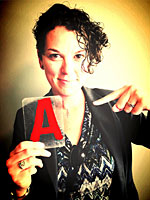In Focus: Aynisa Leonardo, LCAT, ATR-BC
Tell us about your background and what led you to be interested in the field of Creative Arts Therapy.
I began my professional life working in the Pharmaceutical industry and the Entertainment industry. Both of these were interesting to me; however, I felt that neither fully encompassed the path I was looking for. I took several classes at Brooklyn College under a ‘non-degree’ status trying to figure out what graduate program to enroll in. I happened to be taking Art and Psychology classes without knowing that the field of Art Therapy existed. Upon doing some research, I discovered Art Therapy programs and was surprised, relieved, and excited that there was a field that included such a uniquely suited combination. In that moment, I knew what I wanted to pursue.
What attracted you to Hofstra University’s CAT program?
I searched online and found several Art Therapy programs in the NY area. I visited each of them, and Hofstra felt very warm and inviting to me. Upon speaking with and meeting Joan Bloomgarden, I decided to apply to Hofstra. It seemed like a robust and engaging program with a wide variety of options.
Tell us about your relevant experiences outside of the classroom.
I was encouraged by Hofstra professors to do my field work at multiple locations, which at the time felt frustrating. I thought I knew what I was interested in (working with children with Autism). I interned at an outpatient mental health program, a school for children with Autism, and an inpatient hospital, working with a variety of populations. During this time, I learned that my interest was actually working with Trauma Survivors, particularly military and uniformed services. In hindsight, I realized that the encouragement and support I received from Hofstra staff to work at diverse placements was extremely helpful to me. By doing that, I was able to discover my strengths and formulate my focus areas accordingly.
Describe your experience working and studying with faculty in the Department of Counseling and Mental Health Professions.
The faculty at Hofstra were engaging and supportive. Overall, the program was able to successfully pair theoretical education with experiential application. That way, we were learning skills simultaneous to implementing them. Professors who were particularly helpful to me were Vivien Abrams, Joan Alpers, and Margaret Carlock-Russo. They were able to challenge and inspire me, which created an environment of progressive learning.
How did your experience prepare you for your job search? Tell us about your current employment, as well as the private business you have started.
One of my field placements was with an inpatient hospital, Holliswood Hospital, working with adolescents, adults, and the military. Upon completion of that internship, I was immediately hired by the hospital and began my focus in working with trauma and military members in treatment. Unfortunately, the hospital closed in 2013, but I was then hired by Bridge Back to Life, where I am now building an outpatient military program. In addition, I have started a private business called the Military Resilience Project, providing clinical consultation to local organizations, as well as coordinating community-based events. This focused and extensive work all began with my second year Hofstra internship. I am passionate and dedicated to this work and am grateful to have been given the right direction and support along my journey.
What is your advice for prospective students looking for a degree in CAT?
Keep an open mind and try not to limit your initial interests to specific settings and/or populations. Stay sharp to what is going on in the field by speaking to colleagues, attending conferences, and reading up-to-date publications. Be open to working in multi-modal team settings where you collaborate across practices (aka Music Therapists, Drama Therapists, Social Workers, Licensed Mental Health Counselors, Licensed Marriage and Family Therapists, Psychologists). Be creative and assertive about your strengths as a creative therapist. Remember that this is a relatively new field and with that, we carry the bitter sweet responsibility of paving the way for the future of this highly effective and important field.

